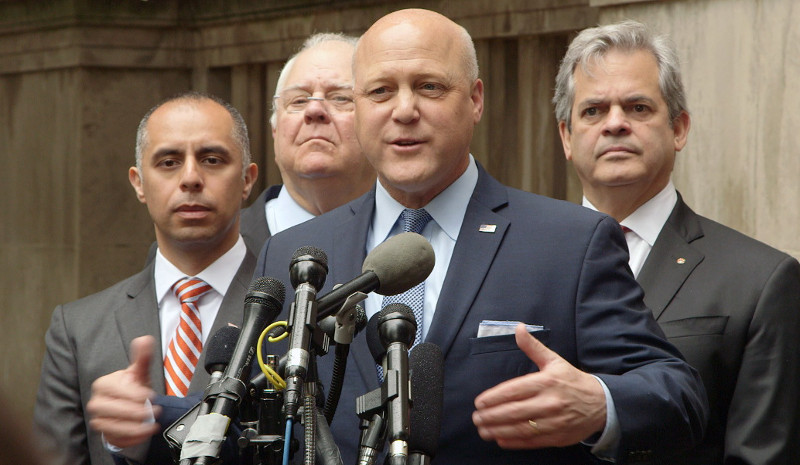The Trump Administration’s withdrawal from the Paris Agreement and distinctly 19th-century approach to energy policy has been seen as a surrender of any hope of American leadership on energy and climate issues. However, it also exposes deep political divides in the United States, particularly as regards those portions of the United States that did not vote for Donald Trump.
The large majority of Trump’s support came from rural and suburban whites, and he won the election not with the majority of the popular vote, but with a majority of states. Trump performed very poorly in large cities and the largest U.S. cities have led the resistance to many of Trump’s policies, including his threat to deport millions of undocumented immigrants.
Energy and climate policies are no exception, and yesterday the U.S. Conference of Mayors produced a series of resolutions that are both a rebuke of the Trump Administration and articulate a vision towards an acceleration of the transition towards renewable energy and electrified transportation.
Mayors representing 1,407 U.S. cities approved nine resolutions under the topic of energy. These included three which called on the Trump Administration and U.S. Congress to change course and commit themselves to the Paris Agreement and Clean Power Plan, as well as return funding to energy efficiency and conservation block grant programs and committing resources to the electrification of the transportation sector.
However, several goals needed no action from Trump or any other federal official. The Conference of Mayors adopted a resolution supporting cities in establishing targets of 100% renewable energy by 2035, including an emphasis on the lowest-cost mechanisms of achieving this and a call for “structured mechanisms” to include low-income citizens in the benefits.
And while the conference of mayors has no power to force any city to adopt such measures, it acknowledged that 31 cities and towns have already taken pledges to move to 100% renewable energy, and six of these cities and towns have already achieved this goal.
The cities that have achieved 100% renewables are all small, with the largest, Burlington, Vermont, having a population of only 42,000. However this cannot be said of the list of 25 cities which have committed to this goal, which include San Diego and San Jose, California, both of which have more than 1 million residents. Chicago, which has 2.7 million residents, has already pledged to move city operations to renewable energy.
This movement by cities underscores an oft-unappreciated dimension of the Energy Transition – that while national governments have often been painfully slow and non-committal in terms of policy support, the void in leadership is being filled by cities and corporations.
And while the aggregate demand in the cities that have made such pledges still represent a small portion of U.S. electricity consumption, the corporations that have made these pledges represent a larger share. Currently 96 corporations have signed on to 100% renewable energy goals, including beverage giant Anheuser-Busch, Walmart, Apple, Microsoft, eBay and Facebook, while Google has already reached its goal to get 100% of its electricity from renewables.
And while 100% renewable energy on a grid level utilizing mostly wind and solar can be dauntingly difficult to achieve and requires massive overbuilding if there is not sufficient flexibly hydroelectric capacity, the goals set by cities and corporations are different. These have the advantage of decarbonizing portions of the grid, thereby accelerating the Energy Transition without necessarily running into some of the technical challenges that are encountered with high levels of renewable energy penetration.
The goals for electrification of transportation are also significant in this regard, as a number of studies have looked at the ability of electric vehicle (EV) charging networks to accommodate higher levels of wind and solar by both absorbing demand at moments of high renewable energy production, as well as the batteries in idle EVs being a resource to be called upon when needed.
The mayors’ pledge also specifically includes biomass. Woody biomass has been opposed by several U.S. and international environmental groups, however biomass encompasses a range of technologies and sources, and some forms of biomass can be provide the kind of flexible, on-demand power that is greatly needed in power systems with high portions of wind and solar. The mayor’s statement seems to encompass these contradictions, stating that “some forms of biomass may be considered renewable energy after being evaluated for sustainability and environmental justice consideration.”
Other forms of biomass such as trash incineration are specifically excluded, as is nuclear power. Despite a campaign by nuclear proponents against 100% renewable energy mandates which has received wide coverage by a sympathetic press, the mayors found no place for nuclear in their clean energy plans.
This content is protected by copyright and may not be reused. If you want to cooperate with us and would like to reuse some of our content, please contact: editors@pv-magazine.com.



By submitting this form you agree to pv magazine using your data for the purposes of publishing your comment.
Your personal data will only be disclosed or otherwise transmitted to third parties for the purposes of spam filtering or if this is necessary for technical maintenance of the website. Any other transfer to third parties will not take place unless this is justified on the basis of applicable data protection regulations or if pv magazine is legally obliged to do so.
You may revoke this consent at any time with effect for the future, in which case your personal data will be deleted immediately. Otherwise, your data will be deleted if pv magazine has processed your request or the purpose of data storage is fulfilled.
Further information on data privacy can be found in our Data Protection Policy.